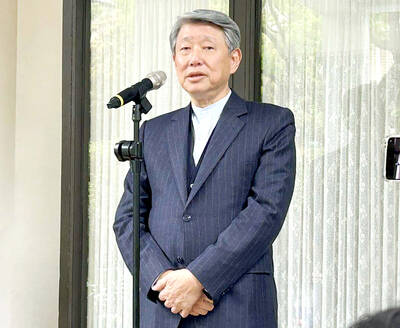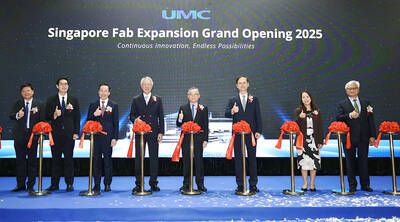Innolux Corp (群創), the LCD panel manufacturing arm of Hon Hai Precision Industry Co (鴻海精密), yesterday said it plans to double its revenue within two years by reviving its electronics assembly business and developing next-generation display technologies.
The production revamp is aimed at minimizing the impact on the company of the LCD industry’s boom-and-bust cycle, Innolux said.
That could also open the door to future cooperation between Innolux and Foxconn Technology Group (富士康科技集團) companies, including Hon Hai and Sharp Corp, it added.
“Since Innolux no longer invests substantially on building new flat-panel [capacity] as Hon Hai and Sharp are doing now, I believe there will certainly be collaboration opportunities between us,” chairman Wang Jyh-chao (王志超) told a media briefing after the company’s annual shareholders’ meeting at its headquarters in Miaoli County.
“We will more than welcome [the chance] to [source] panels from Hon Hai and Sharp for [ TV] assembly,” Wang said.
As Innolux has just resumed its electronics assembly lines, the company has yet to decide whether to make TVs for Hon Hai and Sharp, Wang said.
In March, the flat-panel maker launched a production restructuring plan after its financial status returned to healthy levels. The company had reduced its debt-to-equity ratio to zero last quarter and paid off about NT$200 billion (US$6.58 billion) in debts over a three-year period.
When Innolux was established in 2003, it sold LCD displays and manufactured monitors equipped with its displays for other companies. In 2010, the company spun off its monitor assembly business and sold it to parent company Hon Hai to focus on LCD production following a three-way merger.
Innolux this year started making TVs at its smart factories in Foshan, Guangdong Province, China, Wang said.
The company plans to manufacture 1 milion TVs this year and expects the figure to jump to about 6 million next year and to 10 million in 2019, president and chief operating officer Robert Shiao (蕭志弘) told reporters.
That will help Innolux double its revenue in 2019 from last year’s NT$287.1 billion, according to the company’s forecast.
Innolux also plans to continue developing new display technologies.
Instead of joining its peers in developing micro-LED technology, Innolux is investing in mini-LED technology, said Ting Chin-lung (丁景隆), head of the company’s technology development center.
Mini-LED technology is similar to micro-LED technology, but easier to make, as it uses only 10,000 tiny LEDs to light up a flexible display, compared with 20 million to 30 million for micro-LED, Ting said.
“Our mini-LED technology will be ready in about one year. Then we can start to engage with potential customers,” Ting said.
Innolux shareholders yesterday approved a plan to distribute a cash dividend of NT$0.1 per common share, based on last year’s net profit of NT$1.87 billion, or earnings of NT$0.19 per share.

MULTIFACETED: A task force has analyzed possible scenarios and created responses to assist domestic industries in dealing with US tariffs, the economics minister said The Executive Yuan is tomorrow to announce countermeasures to US President Donald Trump’s planned reciprocal tariffs, although the details of the plan would not be made public until Monday next week, Minister of Economic Affairs J.W. Kuo (郭智輝) said yesterday. The Cabinet established an economic and trade task force in November last year to deal with US trade and tariff related issues, Kuo told reporters outside the legislature in Taipei. The task force has been analyzing and evaluating all kinds of scenarios to identify suitable responses and determine how best to assist domestic industries in managing the effects of Trump’s tariffs, he

TIGHT-LIPPED: UMC said it had no merger plans at the moment, after Nikkei Asia reported that the firm and GlobalFoundries were considering restarting merger talks United Microelectronics Corp (UMC, 聯電), the world’s No. 4 contract chipmaker, yesterday launched a new US$5 billion 12-inch chip factory in Singapore as part of its latest effort to diversify its manufacturing footprint amid growing geopolitical risks. The new factory, adjacent to UMC’s existing Singapore fab in the Pasir Res Wafer Fab Park, is scheduled to enter volume production next year, utilizing mature 22-nanometer and 28-nanometer process technologies, UMC said in a statement. The company plans to invest US$5 billion during the first phase of the new fab, which would have an installed capacity of 30,000 12-inch wafers per month, it said. The

Taiwan’s official purchasing managers’ index (PMI) last month rose 0.2 percentage points to 54.2, in a second consecutive month of expansion, thanks to front-loading demand intended to avoid potential US tariff hikes, the Chung-Hua Institution for Economic Research (CIER, 中華經濟研究院) said yesterday. While short-term demand appeared robust, uncertainties rose due to US President Donald Trump’s unpredictable trade policy, CIER president Lien Hsien-ming (連賢明) told a news conference in Taipei. Taiwan’s economy this year would be characterized by high-level fluctuations and the volatility would be wilder than most expect, Lien said Demand for electronics, particularly semiconductors, continues to benefit from US technology giants’ effort

‘SWASTICAR’: Tesla CEO Elon Musk’s close association with Donald Trump has prompted opponents to brand him a ‘Nazi’ and resulted in a dramatic drop in sales Demonstrators descended on Tesla Inc dealerships across the US, and in Europe and Canada on Saturday to protest company chief Elon Musk, who has amassed extraordinary power as a top adviser to US President Donald Trump. Waving signs with messages such as “Musk is stealing our money” and “Reclaim our country,” the protests largely took place peacefully following fiery episodes of vandalism on Tesla vehicles, dealerships and other facilities in recent weeks that US officials have denounced as terrorism. Hundreds rallied on Saturday outside the Tesla dealership in Manhattan. Some blasted Musk, the world’s richest man, while others demanded the shuttering of his